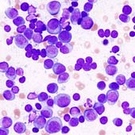Articles tagged with: Plasma Cells
News»

Results from a recent retrospective study suggest that smoldering myeloma patients with a high percentage of plasma cells in the blood are more likely to progress to active myeloma within two years of diagnosis, as compared to patients with a lower percentage of plasma cells.
Patients with more than 5 billion plasma cells per liter of blood or more than 5 percent of their blood cells in the blood being plasma cells were defined as having a ‘high percentage’ of plasma cells in the blood.
“[Our results suggest that] if patients with …
News»

Results from a recent Italian study confirm that smoldering myeloma patients with at least 60 percent of the cells in their bone marrow being plasma cells are 5.6 times more likely than others to progress to symptomatic multiple myeloma.
In addition, the findings indicate that bone marrow aspiration may be a better tool than bone marrow biopsy for predicting rapid progression from smoldering to active myeloma.
The study investigators suggest that smoldering myeloma patients with at least 60 percent plasma cells should be treated soon after diagnosis.
However, Dr. Ola Landgren from …
News»

Korean researchers recently found that the percentage of cancerous plasma cells in the bone marrow, measured on day 14 post transplant, may predict disease progression in multiple myeloma patients following high-dose chemotherapy and stem cell transplantation.
However, because their study was small and retrospective in nature, the Korean researchers suggested that further studies be conducted to confirm their findings.
The standard treatment for myeloma patients under the age of 65 years currently consists of high-dose chemotherapy, followed by autologous stem cell transplantation. In this type of transplantation, physicians collect a patient’s stem …
News»

A recent study suggests that relapsed/refractory myeloma patients with abnormal plasma cells in the blood prior to therapy have a more aggressive form of multiple myeloma. Furthermore, the study authors speculated that if the number of abnormal plasma cells did not decrease following one cycle of therapy, it may be indicative of treatment resistance.
These findings were presented at the European Hematology Association (EHA) meeting in Barcelona, Spain, last month.
Multiple myeloma is a disease characterized by abnormal plasma cells. Plasma cells are typically located in the bone marrow, but they can …

